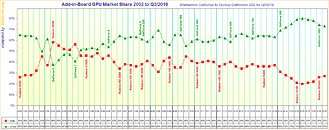wolf
Better Than Native
- Joined
- May 7, 2007
- Messages
- 8,858 (1.33/day)
| System Name | MightyX |
|---|---|
| Processor | Ryzen 9800X3D |
| Motherboard | Gigabyte B650I AX |
| Cooling | Scythe Fuma 2 |
| Memory | 32GB DDR5 6000 CL30 tuned |
| Video Card(s) | Palit Gamerock RTX 5080 oc |
| Storage | WD Black SN850X 2TB |
| Display(s) | LG 42C2 4K OLED |
| Case | Coolermaster NR200P |
| Audio Device(s) | LG SN5Y / Focal Clear |
| Power Supply | Corsair SF750 Platinum |
| Mouse | Corsair Dark Core RBG Pro SE |
| Keyboard | Glorious GMMK Compact w/pudding |
| VR HMD | Meta Quest 3 |
| Software | case populated with Artic P12's |
| Benchmark Scores | 4k120 OLED Gsync bliss |
The folks over at 3dcenter.org have compiled comprehensive historical GPU AIB market share data for our digestion. While we recently reported on Q3'16 and its comparison to the quarter before and the same period last year, this information spans a near 14 year quarter-on-quarter time frame. The compilers have quite helpfully included points of reference along the timeline which highlight the two major GPU manufacturers milestone desktop product line debuts.
It is worth noting that their exact numbers differ slightly to the ones Jon Peddie Research provided as 3dcenter have also cited the work of Mercury Research, which appears more conservative. The figures provided in their own graph split the difference between the two sources to give us a more impartial look at the market.

Back in 2002, the two GPU manufacturers were in the earlier stages of their rivalry to dominate the desktop graphics card market. A typical PC powered by either would have utilized an "ATI" (Before their purchase by AMD in 06') Radeon 8/9000 Series or GeForce 2 MX/Ti series graphics card. The average amount of on-board video memory was 64 or 128MB accompanied by 2, 4 or if you were lucky, 8 pixel shader units. The most popular screen resolution was 1024x768, and probably on a CRT monitor. Leading API's at the time were DirectX 8.1 and OpenGL 1.3.
Fast forward to anno 2016 and some 10-15 generations of GPU later, your average on-board video memory is closer to 4 or 8GB, and now far more complex clusters of computational units that have superseded shaders number in the thousands. A typical gamers screen resolution is 1920x1080 or in many cases, beyond - not to mention the advent of VR. Both major API's are evolving too, now aiming to have much more efficient low level hardware access and less resource overhead with Microsoft's DirectX 12 and the Successor to OpenGL 4.5, Vulkan.
View at TechPowerUp Main Site
It is worth noting that their exact numbers differ slightly to the ones Jon Peddie Research provided as 3dcenter have also cited the work of Mercury Research, which appears more conservative. The figures provided in their own graph split the difference between the two sources to give us a more impartial look at the market.

Back in 2002, the two GPU manufacturers were in the earlier stages of their rivalry to dominate the desktop graphics card market. A typical PC powered by either would have utilized an "ATI" (Before their purchase by AMD in 06') Radeon 8/9000 Series or GeForce 2 MX/Ti series graphics card. The average amount of on-board video memory was 64 or 128MB accompanied by 2, 4 or if you were lucky, 8 pixel shader units. The most popular screen resolution was 1024x768, and probably on a CRT monitor. Leading API's at the time were DirectX 8.1 and OpenGL 1.3.
Fast forward to anno 2016 and some 10-15 generations of GPU later, your average on-board video memory is closer to 4 or 8GB, and now far more complex clusters of computational units that have superseded shaders number in the thousands. A typical gamers screen resolution is 1920x1080 or in many cases, beyond - not to mention the advent of VR. Both major API's are evolving too, now aiming to have much more efficient low level hardware access and less resource overhead with Microsoft's DirectX 12 and the Successor to OpenGL 4.5, Vulkan.
View at TechPowerUp Main Site
Last edited:







